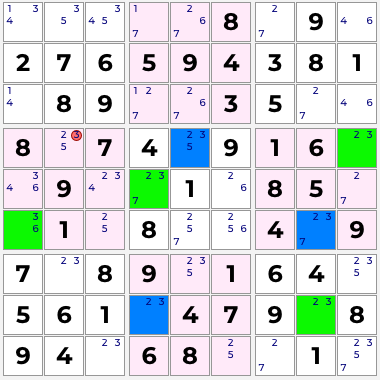How it works
When there are only 2 candidates for a digit in a row, column, or box these cells are strongly linked. If the digit is placed in one of them (true), it can’t be placed in the other (false). This is also called a conjugate pair. Coloring techniques can be used to mark the parity of candidates that are strongly linked. A chain of strongly linked cells is also called a cluster.
The simple colors technique use 2 colors to mark the candidates of a single digit. Parities are used to define opposite states, where one candidate can’t be true together with another (different parities). One color will represent one parity, and the other color will represent the other.
Any candidates with the same parity/color must be true or false at the same time. Any candidates with different colors can’t be true or false at the same time, if one color is true, then other must be false.
By creating a chain of conjugate pairs, alternating the parity between each cell in the pair allows us to track which candidates that always will have a value. Any candidates that is not part of the chain, but can see both colors can never contain the digit, and the candidate can be eliminated from them.
If one of the colors end up seeing itself, it would create a contradiction as there would be multiple instances of the same digit within that house. If that happens, the entire chain will become invalid, and all the candidates with that color can be eliminated.
Examples
Here we use the colors green and blue to represent the parities. One candidate in all conjugate pairs for the digit 3 have been marked with blue, the other with green. Now we know that all green cells must contain the digit 3, or all candidates with blue must contain the digit. This allows us to eliminate the candidate in r4c2 as it can be seen by both the colors.
